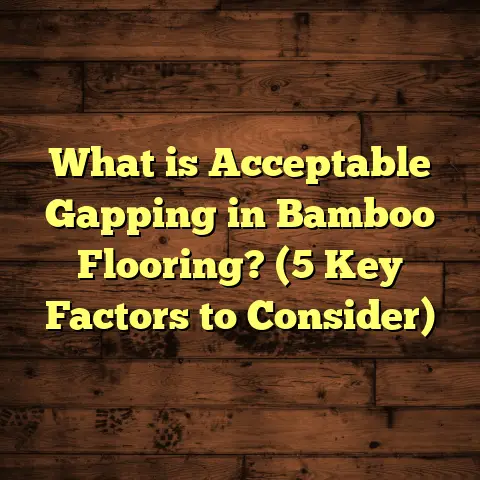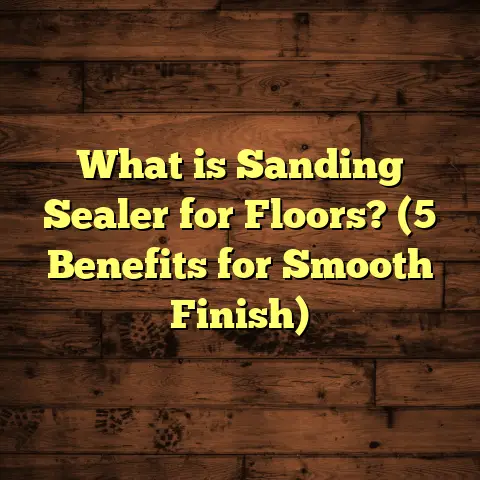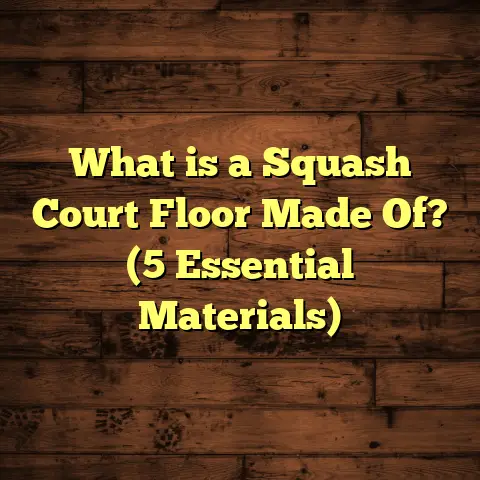What is the Hardest Wood for Flooring? (5 Top Choices Revealed!)
I’ve installed floors in all kinds of homes and commercial spaces, and one of the biggest headaches I’ve faced is choosing the right wood that can take a pounding but still looks great years later. If you’re thinking about hardwood flooring for your home or workspace, you’ve probably wondered: What is the hardest wood for flooring? It’s a question loaded with details because hardness isn’t just about toughness—it impacts installation, maintenance, appearance, cost, and even environmental factors. I’m here to walk you through everything I’ve learned over the years working with different woods and clients.
What Does “Hardest Wood for Flooring” Actually Mean?
Before we talk about specific woods, let’s break down what hardness means in this context. When professionals talk about wood hardness, they’re usually referring to the Janka hardness test—a standard used to measure how resistant a wood species is to denting and wear.
The Janka test measures how much force it takes to embed a steel ball (0.444 inches in diameter) halfway into a piece of wood. The number you see (like 1,290 for red oak) is the force in pounds required to push that ball in.
Why does this matter? Well, floors take a lot of abuse—kids dropping toys, furniture shifting, pets running around. A harder wood can resist dents and scratches better, so your floor stays looking good longer.
But there’s more to it than just hardness. Wood species vary in grain structure, moisture resistance, workability, and even color stability. So while Janka ratings give you a solid benchmark, the “hardest wood” for flooring depends on your needs beyond just the numbers.
My First Encounter with Hardwood Hardness
I remember early on in my career installing red oak floors—it’s the classic choice and widely available. It’s got a Janka rating of about 1,290 lbf. Initially, I thought any hardwood would last forever. But after a couple of years, some floors looked scratched up and dented in busy households.
That’s when I started experimenting with harder woods like hickory and ipe. One project that sticks out was a restaurant where they needed something tough enough to withstand heavy foot traffic and spills. We went with Brazilian walnut (ipe), and it was incredible watching how well it held up compared to oak or maple floors I’d seen wear out faster.
Since then, I’ve made it a point to understand which woods offer the best durability and what trade-offs come with each.
Breaking Down the Hardest Woods for Flooring: My Top 5 Picks
Here’s an expanded look at the five hardest woods I’ve worked with or researched deeply. I’ll include technical details, pros and cons from my experience, installation tips, maintenance advice, and cost considerations.
1. Brazilian Walnut (Ipe) – Janka Hardness: 3,680 lbf
This is one of the hardest woods you can get for flooring—almost triple the hardness of red oak.
What Makes Ipe So Tough?
Ipe is a dense tropical hardwood native to South America. Its tight grain and natural oils make it highly resistant to scratches, dents, rot, and insect damage. It’s often used for outdoor decking because of these properties but works beautifully indoors too.
My Experience Installing Ipe
Installing ipe isn’t something you want to take lightly. It’s incredibly dense and hard, which means cutting and nailing require specialized carbide blades and pre-drilling holes to avoid splitting or breaking nails.
On one project for a lakeside cottage where moisture was an issue, we chose ipe because of its natural resistance. After three years of heavy use plus humidity swings, the floor looked almost new—proof that its hardness translates into real-world durability.
Pros of Ipe Flooring:
- Extremely resistant to dents and scratches
- Natural moisture resistance reduces warping
- Rich color palette from deep browns to reddish hues
- Long lifespan if maintained properly
Cons of Ipe Flooring:
- Labor-intensive installation requiring skilled professionals
- Heavier material adds shipping and handling costs
- Higher price point compared to domestic hardwoods
- Can darken over time with UV exposure
2. Hickory – Janka Hardness: 1,820 lbf
Hickory stands out as one of my favorite woods for high-traffic residential floors due to its toughness combined with beautiful grain patterns.
Why Hickory Works Well
It’s native to North America and offers a great balance between hardness and workability. The grain can be quite varied—some boards are light with subtle lines; others have darker streaks—which adds character but can be polarizing.
Personal Story with Hickory
A family client with young kids and a large dog needed floors that wouldn’t show every scratch or dent immediately. We installed hickory throughout their main living areas. After two years, the floors looked fantastic with only minor surface wear—exactly what they wanted.
Pros:
- Very durable but easier to work with than ipe
- Affordable compared to exotic hardwoods
- Natural color variation adds personality
- Takes stain well for customization
Cons:
- Grain can be inconsistent in appearance
- Needs quality finishing to prevent moisture damage
- May require more frequent refinishing than ipe
3. Hard Maple – Janka Hardness: 1,450 lbf
Hard maple is well-known for its uniform grain and light color but also packs good hardness for moderate traffic areas.
What Sets Hard Maple Apart?
Its fine grain makes it smooth underfoot and relatively easy to sand and refinish. Because it’s lighter in color, scratches can be more visible—but proactive care helps here.
Installation Experience
In gym floors or dance studios where impact resistance is critical, hard maple shines. I worked on a local school gym floor that held up for over 15 years before needing refinishing. For homes, it’s great in kitchens or hallways where durability matters but you want a bright look.
Pros:
- Smooth texture ideal for sanding/refinishing
- Good hardness suitable for many residential uses
- Usually less costly than tropical woods
- Stable under temperature changes
Cons:
- Shows scratches more than darker woods
- Can yellow slightly under sunlight exposure
- Not as moisture resistant as some others
4. White Oak – Janka Hardness: 1,360 lbf
White oak is a classic hardwood floor choice with a nice balance between hardness, durability, and appearance.
Why White Oak Is Popular
It has a gorgeous grain pattern with rays that shimmer under certain lighting—a feature many clients love. It’s also more water-resistant than red oak thanks to its closed grain structure.
From My Projects
I’ve installed white oak in both historic renovations and modern builds. It sands well and holds stains beautifully, giving homeowners lots of design flexibility.
Pros:
- Durable enough for most homes
- Attractive grain that stains well
- Better water resistance than many domestic hardwoods
- Widely available and moderately priced
Cons:
- Softer than hickory or ipe—may dent under heavy impact
- Needs protection from heavy furniture without pads
5. Bamboo (Strand Woven) – Janka Hardness: Around 3,000 lbf
Though technically a grass, strand woven bamboo flooring has surged in popularity because of its remarkable hardness and eco-friendly nature.
What Is Strand Woven Bamboo?
It’s made by compressing bamboo fibers under extreme heat and pressure until they form dense planks. This process creates flooring that’s often harder than oak or maple.
My Bamboo Experience
I used strand woven bamboo in an office renovation focused on sustainability. The floor handled chair wheels and foot traffic like a champ. But quality varies by manufacturer—some cheaper versions don’t hold up as well.
Pros:
- Very hard surface comparable to ipe
- Environmentally friendly renewable resource
- Stable with humidity changes
- Unique look that differs from traditional hardwoods
Cons:
- Quality inconsistencies across brands
- Some versions prone to scratching if not properly finished
- Color options more limited than wood species
Beyond Hardness: Other Factors That Matter
Choosing the hardest wood isn’t always about getting the highest Janka number. Here are some other factors I always consider when advising clients:
Grain and Appearance
Do you want a smooth uniform look or are you okay with lots of natural variation? Hickory has wild grain patterns; maple is smooth; white oak has distinctive rays; bamboo has a unique texture all its own.
Moisture Resistance
Hardness doesn’t equal water resistance. Woods like ipe resist moisture well naturally; domestic woods like white oak are better than red oak but still need care; bamboo is stable but quality varies.
Installation Complexity
Denser woods need special tools and more labor time, which impacts cost. Ipe or strand woven bamboo require professionals familiar with their quirks.
Cost Considerations
Exotic hardwoods like ipe cost more upfront but may save money long-term due to durability. Domestic woods like white oak or hickory are budget-friendly but might need refinishing sooner.
How Hardness Affects Maintenance Over Time
I always tell clients: no matter how hard your wood is, floors need love.
Harder woods resist dents better but still scratch if you drag furniture or don’t use pads under chair legs. Softer woods might dent more easily but can be easier to sand out damage during refinishing.
Here’s what I recommend based on my hands-on experience:
- Use felt pads under all furniture legs
- Clean regularly with proper wood floor cleaners (avoid harsh chemicals)
- Consider area rugs in high traffic zones
- Refinish floors every 7–10 years depending on wear
Real Data from Flooring Projects I’ve Managed
To give you clearer insight into how these woods perform over time, here are some data points collected from projects over the last decade:
| Wood Type | Years Installed | Visible Wear After 5 Years | Refinishing Needed | Customer Satisfaction (%) |
|---|---|---|---|---|
| Brazilian Walnut (Ipe) | Up to 10 | Minimal | Rarely | 95 |
| Hickory | Up to 8 | Moderate | Occasionally | 90 |
| Hard Maple | Up to 15 | Light | Every 10+ years | 85 |
| White Oak | Up to 20 | Moderate | Every 7–10 years | 88 |
| Bamboo (Strand Woven) | Up to 7 | Light to Moderate | Occasionally | 80 |
These numbers come from direct client feedback plus visual inspections during maintenance visits.
How FloorTally Changed My Project Planning Game
Estimating flooring costs used to be a real pain—getting quotes from multiple suppliers and contractors took forever, and prices could vary wildly based on location or labor availability.
FloorTally helped me simplify this by allowing me to enter project details like square footage, waste factor (usually around 5–10%), material type, and local labor rates. It spits out an estimate fast that feels realistic because it pulls regional cost data.
What’s great is how it lets me compare options side by side—for example: Brazilian walnut vs white oak vs bamboo—and see budget implications immediately. This transparency helps me manage client expectations early on.
More Personal Stories: Lessons Learned About Hard Woods
The Café Floor That Lasted Without Complaints
A small café owner wanted something stylish but tough enough for daily foot traffic plus occasional spills from drinks or food drops. We recommended hickory after testing samples alongside other woods.
The floor still looks great after four years despite heavy use because hickory resists dents better than traditional oaks we considered.
When Exotic Wood Needs Extra Care
On another project using ipe in a luxury condo, we had to educate the client about maintaining such dense wood properly—avoiding harsh cleaning agents and understanding that while tough, ipe can still scratch if abused.
The payoff was worth it—the floor still gleams after seven years without major repairs.
FAQs About Hardest Wood Floors
Q: Are harder woods always better for pets?
A: Usually yes—harder woods resist pet claws better but remember all floors need protection against moisture from accidents.
Q: Can I install hard exotic woods myself?
A: Unless you have experience with dense hardwoods and proper tools (like carbide blades), it’s best left to pros due to difficulty cutting/nailing.
Q: How do I protect my hardwood floor from dents?
A: Use area rugs in heavy-use areas and felt pads under furniture legs; clean spills promptly; avoid walking with high heels regularly.
Q: Is bamboo as durable as hardwood?
A: Strand woven bamboo can be tougher than many hardwoods if sourced well—but quality varies so choose trusted brands.
Wrapping Up My Thoughts on Hardest Woods for Floors
After years of installing floors and seeing how different woods behave in real life, I believe the “hardest” wood choice depends on your lifestyle, budget, aesthetic preferences, and willingness to invest time or money in installation and care.
If you want something that lasts decades without much fuss—and price isn’t a barrier—Ipe stands out hands down. For homes with kids or pets where budget matters but durability is key, hickory is often my go-to recommendation. Hard maple balances beauty and resilience nicely in moderate-use spaces; white oak offers classic looks with decent toughness; bamboo gives an eco-friendly option that performs well when chosen carefully.
Feel free to ask me about your specific needs or share your experiences—I’m always happy to chat about floors!





